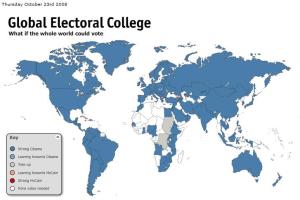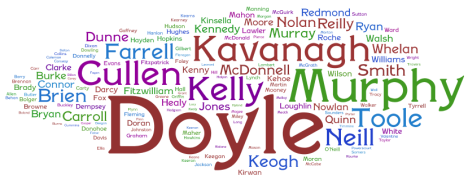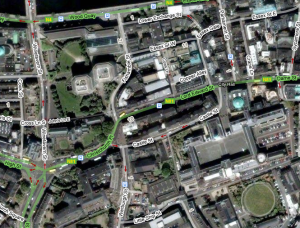Last-minute prediction: Obama by a landslide! No, wait… a 269-269 electoral college dead heat
After all my poll-watching, I’ve decided to throw my hat in the rang one last time, and engage in that most dangerous of sports: the last-minute prediction. Last minute predictions give the predictor the least time to live in comfort in the time between prediction and outcome, and most danger of subsequent accusations of being wildly wrong despite having all the best poll data to hand. Hence, they’re not that popular.
Still, they are fun. So here goes. Let the ridiculing of me start in about 24 hours!
McCain has 134 votes from sixteen states ‘in the bag’, all unsurprisingly Bush states from 2000 and 2004: Texas, Tennessee, Arizona, Alabama, Louisiana, Kentucky, South Carolina, Oklahoma, Arkansas, Kansas, Mississippi, Nebraska, Utah, Idaho, Alaska and Wyoming. Of these, only Arizona even looks like wavering, and I think home bias will win through there. A further four states are going McCain’s way, worth 26 votes in total: Georgia, West Virginia, Montana, South Dakota. These twenty states would give McCain 160 votes.
Obama has 218 electoral college votes ‘in the bag’, it seems at this stage: all the Kerry-Gore states from the last two elections, plus Iowa (which went to Gore last time out) and New Hampshire (which went to Bush). That is, armed with little else but a range of polls and past voting records, I think Obama will easily win the following 18 states:
- California, New York, Illinois, Michigan, New Jersey, Massachusetts, Washington, Maryland, Connecticut, Iowa, Oregon, Hawaii, Maine, New Hampshire, Rhode Island, DC, Delaware and Vermont
I also think it’s very likely that another 41 votes across three states are Obama’s, bringing him to 259 and just an Indiana or Missouri away from the US presidency: Pennsylvania, Minnesota, Wisconsin, again all Kerry-Gore states since 2000. (Although with Maine splitting its electoral college votes, technically he may only have 257 from these 21 states, but will more than likely make up for this by picking up two in Nebraska, which operates the same system.)
So Obama’s 21-20 victory in states would leave him 259-160 ahead.
What makes it ominous for McCain is that a further 47 electoral college votes look like they could be going Obama’s way – although these are most susceptible to a Bradley effect swing of say 5%, as his lead is smallest in these four states: Ohio (20), Virginia (13), Colorado (9), New Mexico (5). Of all these four states, only New Mexico in 2004 did not vote for Bush in the last two elections. If the Bradley effect or some other gap between poll and reality were to deny him even two of these states, Obama would still win the presidency.
And that’s before factoring in the six true toss-ups worth 72 votes, which interestingly are all Bush 2000-2004 states: Florida (27), North Carolina (15), Indiana (11), Missouri (11), Nevada (5), North Dakota (3). Current polls suggest this will probably split down the middle, maybe 32 to Obama and 40 to McCain. Taking these at face value, and assuming either (a) no Bradley effect, or (b) that the Bradley effect and the no-landline effect cancel each other out suggests a win for Obama in the region of 338 to 200.
If we take states like Arizona as safe and call this margin the top end, what’s the bottom end of the spectrum? A 5-point Bradley effect, or something similar, could cost Obama Florida (27), Ohio (20), Virginia (13) and possibly Colorado (9), worth together 69 votes. The mathematically sharp-minded amongst you will have spotted that a 338-200 outcome with 69 votes redistributed gives us: 269-269, a tie!
Personally, I think we’ll be closer to the upper end for Obama, but the fact that the polls leave us the possibility of a tie is certainly one to watch, if some states start falling unexpectedly on McCain’s side. Failing that, it may bring some electoral attention away from Florida and Ohio and Pennsylvania to Colorado for a change!




